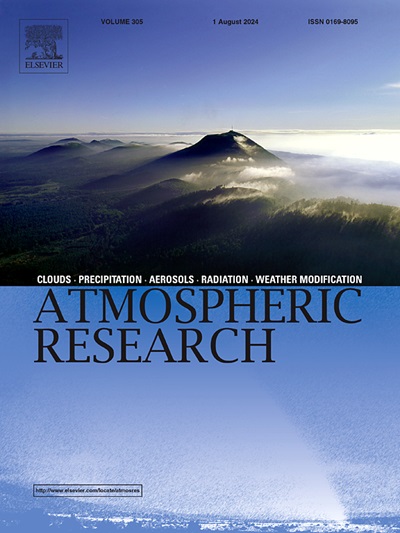Interdecadal variability in the dominant synoptic patterns responsible for the summer daily extreme precipitation over the Tarim Basin, Northwest China
IF 4.5
2区 地球科学
Q1 METEOROLOGY & ATMOSPHERIC SCIENCES
引用次数: 0
Abstract
Revealing the synoptic patterns associated with extreme precipitation is important in deepening our understanding of extreme precipitation formation. To examine whether the synoptic patterns responsible for the summer extreme precipitation (SEP) have experienced an interdecadal variability over the Tarim Basin (TB), we investigate and compare the synoptic patterns influencing regional SEP over the TB under different interdecadal backgrounds. Results show the SEP over the TB has experienced three distinct periods (1961–1987: dry period; 1988–2009: wet period I; 2010–2023: wet period II) and can be categorized into two dominant patterns, western pattern, and eastern pattern, respectively. The western and eastern patterns of SEP are dominated by the large-scale circulations characterized by directly influenced circulations: Subtropical Westerly Jet (SWJ), Central Asian Cyclone (CAC) and low-level easterly jet/cyclone, which affect the dynamics conditions, as well as indirectly influenced circulations: South Asian High (SAH), Iranian Subtropical High (ISH), Western Pacific Subtropical High (WPSH), Mongolian Anticyclone (MAC) and Siberian Ridge, which modulate water vapor transport. During the Dry Period to Wet Period II, with the increasing influence of the WPSH and MAC, the source and path of water vapor transport yielded an interdecadal adjustment from the Arabian Sea to the Bay of Bengal to the western Pacific Ocean. Regarding the SEP-dominant transition, the differences between the patterns are the location of the SWJ, CAC, and MAC, resulting in substantially different water vapor transport. In the western pattern, the change occurs mainly in the western water vapor path, whereas in the eastern pattern, it is the eastern water vapor that undergoes interdecadal changes. Moreover, discrepancies in the variations of ISH and WPSH in sub-periods not only contribute to the interdecadal variations, but also are responsible for variances between patterns.
造成中国西北塔里木盆地夏季日极端降水量的主要同步模式的年代际变化
揭示与极端降水相关的同步模式对于加深我们对极端降水形成的理解非常重要。为了研究造成塔里木盆地夏季极端降水(SEP)的同步模式是否经历了年代际变化,我们研究并比较了不同年代际背景下影响塔里木盆地区域SEP的同步模式。结果表明,塔里木盆地上空的 SEP 经历了三个不同时期(1961-1987 年:干旱期;1988-2009 年:湿润期 I;2010-2023 年:湿润期 II),并可分别划分为西部模式和东部模式两种主导模式。东南太平洋的西部模式和东部模式以直接影响环流的大尺度环流为主:这些环流包括影响动力学状况的亚热带西风喷流(SWJ)、中亚气旋(CAC)和低层东风喷流/气旋,以及间接影响的环流:南亚高气压(South Asian High,SAH)、伊朗副热带高气压(Iranian Subtropical High,ISH)、西太平洋副热带高气压(Western Pacific Subtropical High,WPSH)、蒙古反气旋(Mongolian Anticyclone,MAC)和西伯利亚海脊(Siberian Ridge)会调节水汽输送。在干旱期到湿润期 II 期间,随着 WPSH 和 MAC 影响的增加,水汽输送的来源和路径产生了从阿拉伯海到孟加拉湾再到西太平洋的年代际调整。关于 SEP 主导的过渡,模式之间的差异在于 SWJ、CAC 和 MAC 的位置,导致水汽输送有很大不同。在西部模式中,变化主要发生在西部水汽路径上,而在东部模式中,发生年代际变化的是东部水汽。此外,ISH 和 WPSH 在各子期的变化差异不仅造成了年代际变化,也是造成模式间差异的原因。
本文章由计算机程序翻译,如有差异,请以英文原文为准。
求助全文
约1分钟内获得全文
求助全文
来源期刊

Atmospheric Research
地学-气象与大气科学
CiteScore
9.40
自引率
10.90%
发文量
460
审稿时长
47 days
期刊介绍:
The journal publishes scientific papers (research papers, review articles, letters and notes) dealing with the part of the atmosphere where meteorological events occur. Attention is given to all processes extending from the earth surface to the tropopause, but special emphasis continues to be devoted to the physics of clouds, mesoscale meteorology and air pollution, i.e. atmospheric aerosols; microphysical processes; cloud dynamics and thermodynamics; numerical simulation, climatology, climate change and weather modification.
 求助内容:
求助内容: 应助结果提醒方式:
应助结果提醒方式:


